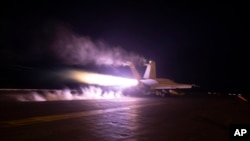The United States hit Iranian-backed targets in Iraq and Yemen in a span of about two hours early Wednesday morning, striking a militant headquarters in Iraq and knocking out more missiles in Yemen that were ready to launch into international shipping lanes, according to the U.S. military.
U.S. military aircraft hit the Iranian-backed proxies in Iraq just after midnight local time in response to a series of attacks against U.S. and coalition forces in recent days.
U.S. officials said the airstrikes targeted three facilities in western Iraq used by Kataib Hezbollah and other Iranian proxy groups.
“These strikes targeted KH [Kataib Hezbollah] headquarters, storage, and training locations for rocket, missile, and one-way attack UAV [unmanned aerial vehicle] capabilities,” according to a statement from U.S. Central Command, which oversees U.S. forces in the region.
U.S. Defense Secretary Lloyd Austin warned, separately, that Washington is not ruling out additional strikes, if necessary.
"We do not seek to escalate conflict in the region," Austin said in a statement, adding, "We are fully prepared to take further measures to protect our people and our facilities."
"We call on these groups and their Iranian sponsors to immediately cease these attacks," he said.
The new U.S. strikes – targeting sites in the towns of al-Qaim and Jurf al Sakhar, and one other location in western Iraq – came shortly after Iranian-backed militants attacked Ain al-Asad air base in western Iraq with one-way attack drones.
The base was also targeted on Saturday by a barrage of ballistic missiles launched from inside Iraq. While most of the missiles were shot down, Pentagon press secretary Major General Pat Ryder said those that landed on base caused traumatic brain injuries in four U.S. personnel.
More than 150 attacks on US forces
There have been more than 150 attacks on U.S. forces in Iraq and Syria since the Oct. 7 Hamas terror attack against Israel, injuring at least 83 Americans in Iraq and Syria, a U.S. defense official told VOA. All but two have returned to duty.
About two hours after the attack in Iraq, the U.S. military stuck two anti-ship missiles in a Houthi-controlled area of Yemen that were prepared to launch and posed an imminent threat to maritime vessels, according to U.S. Central Command. Another anti-ship missile had been taken out by U.S. forces on Tuesday, according to Ryder.
The anti-ship missile attacks were preceded by a series of strikes launched into Yemen on Tuesday by U.S. and British warplanes, backed by surface ships and submarines, to further degrade the capabilities of the Iranian-backed Houthi militants who have sought to carry out attacks against key shipping lanes in the Middle East.
U.S. defense officials said the strikes hit multiple targets across eight locations, including an underground storage facility as well as missile launch sites and other locations linked to Houthi surveillance capabilities.
The strike locations were intentionally selected to target weapons systems, not to amass casualties, a senior military official told reporters. The official assessed the underground storage facility had "more advanced conventional weaponry" in it than sites hit in the first round of strikes on Jan. 11.
UN leader urges 'all parties to step back'
United Nations Secretary-General Antonio Guterres on Tuesday urged "all parties to step back from the brink and to consider the horrendous human cost of a regional conflict."
Ryder told reporters in response to a question from VOA that the U.S. was "not at war" in the Middle East.
"Our goal here is to ensure the Red Sea is safe and secure for international shipping. That is our only goal," he added.
The Red Sea route carries about 15% of the world's maritime traffic. Major shipping companies have responded to the attacks by rerouting vessels on the longer and more expensive route around Africa.
A U.S. defense official said Monday the decline in the number and the ferocity of the Houthis' maritime attacks was directly attributed to the reduction in their capabilities.
"That does not mean they have no more capability, but we definitely believe that has had an impact," another U.S. official said.
Since mid-November, the Houthis have launched 33 attacks on international shipping lanes, according to the Pentagon. The Houthis say their attacks are in solidarity with Palestinians in Gaza under attack from Israel.
Many of the Houthi attacks have targeted ships that are not associated with Israel.







